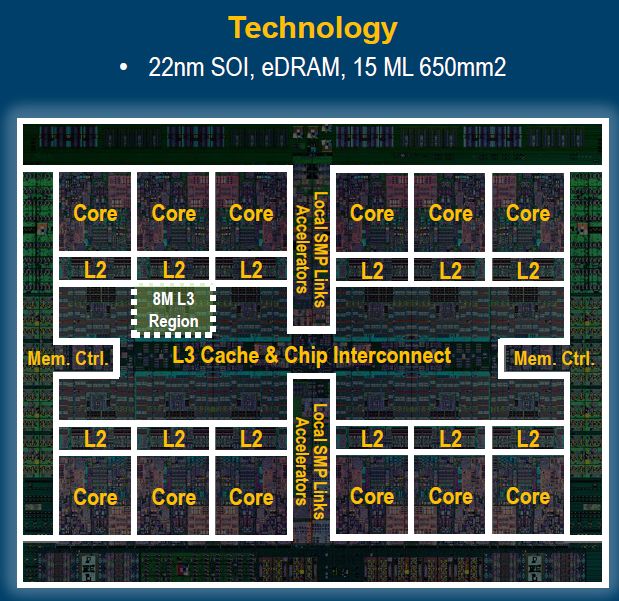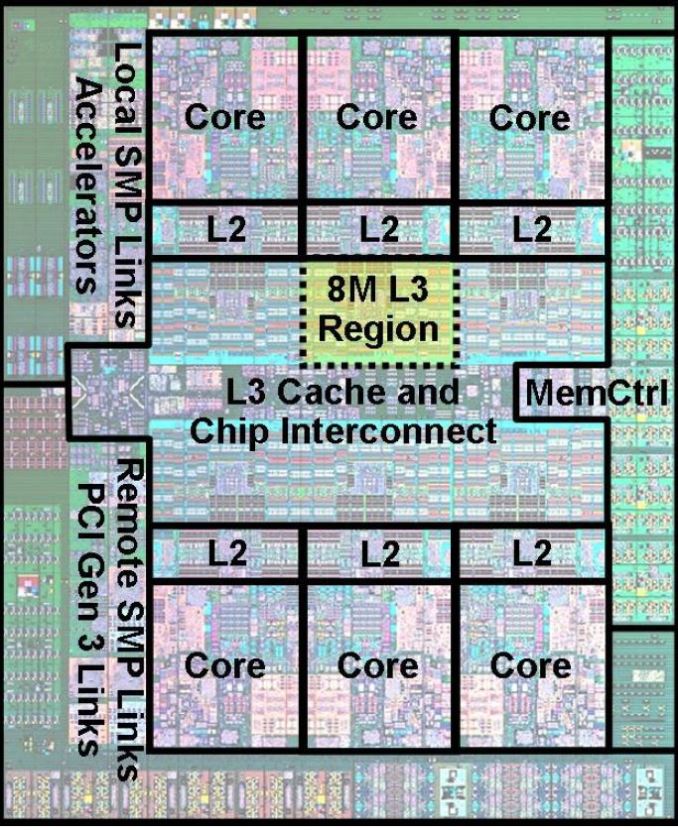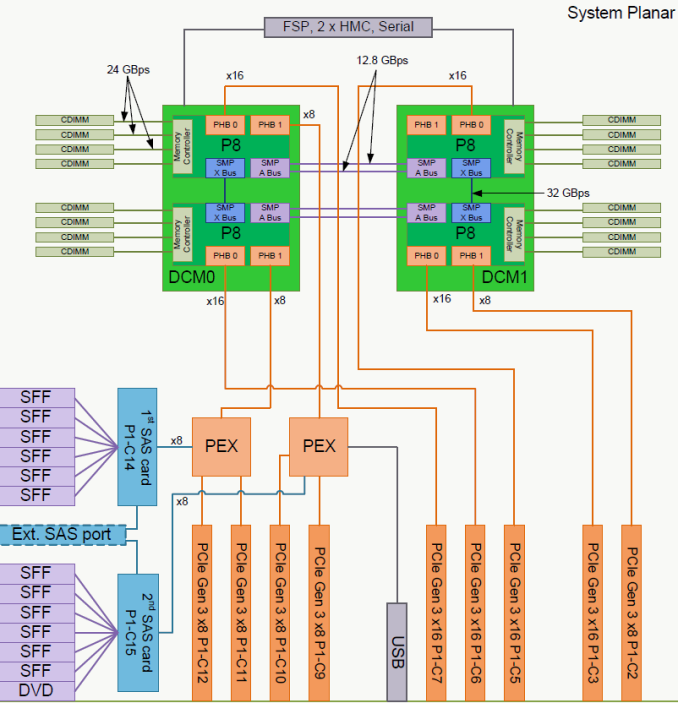The IBM POWER8 Review: Challenging the Intel Xeon
by Johan De Gelas on November 6, 2015 8:00 AM EST- Posted in
- IT Computing
- CPUs
- Enterprise
- Enterprise CPUs
- IBM
- POWER
- POWER8
Inside the S822L: Hardware Components
The 2U Rack-mount S822L server contains two IBM POWER8 DCM sockets. Each socket thus contains two cores connected by a 32GBps interconnect. The reason for using a Multi-Chip-Module (MCM) is pretty simple. Smaller five-to-six core dies are a lot cheaper to produce than the massive 650 mm² monolithic 12-core dies. As a result the latter are reserved for IBM's high-end (E880 and a like). So while most POWER8 presentations and news posts on the net talk about the multi-core die below...
... it is actually an MCM with two six core dies like the one below that is challenging the 10 to 18 core Xeons. The massive monolithic 10-12 core dies are in fact reserved for much more expensive IBM servers.
The layout of the S822L is well illustrated by the scheme inside the manual.
Each DCM offers 48 PCIe Gen 3 lanes. 32 of those lanes are directly connected to the processor while 16 connect to PCIe switches. The PCIe switches have "only" 8 lanes upstream to the DCM, but offer 24 lanes to "medium" speed devices downstream. As it unlikely that both your SAS controllers and your network controllers will gobble up the full PCIe x8 bandwidth, this is a very elegant way to offer additional PCIe lanes.













146 Comments
View All Comments
Kevin G - Saturday, November 7, 2015 - link
If all you do is just mount the network volume to use the data, then likely nothing at all. While binaries do have to be modified, the file systems themselves are written to store data in a single consistent manner. If you're wondering more if there would be some overhead in translating from LE to BE to work in memory, conceptually the answer is yes but I'd predict it be rather small and dwarfed by the time to transfer data over a network. I'd be curious to see the results.Ultiamtely I'd be more concerned with kernel modules for various peripherals when switching between LE and BE versions. Considering that POWER has been BE for a few generations and you did your initial testing using LE, availability shouldn't be an issue. You've been using the version which should have had the most problems in this regard.
spikebike - Friday, November 6, 2015 - link
So basically power is somewhat competitive with intel's WORST price/perf chips which also happen to have the worst memory bandwidth/CPU. Seems nowhere close for the more reasonable $400-$650 xeons like the D-1520/1540 or the E5-2620 and E5-2630. Sure IBM has better memory bandwidth than the worst intels, but if you want more memory bandwidth per $ or per core then get the E5-2620.JohanAnandtech - Saturday, November 7, 2015 - link
It is definitely not an alternative for applications where performance/watt is important. As you mentioned, Intel offers a much better range of SKUs . But for transactional databases and data mining (traditional or unstructured), I see the POWER8 as very potent challenger. When you are handling a few hundreds of gigabytes of data, you want your memory to be reliable. Intel will then steer you to the E7 range, and that is where the POWER8 can make a difference: filling the niche between E5 and E7.nils_ - Wednesday, November 11, 2015 - link
Especially if you're running software that doesn't easily scale out very well these are very competitive. And nowadays even MySQL will scale-up nicely to many, many cores.Gigaplex - Friday, November 6, 2015 - link
"Less important, but still significant is the fact that IBM uses SAS disks, which increase the cost of the storage system, especially if you want lots of them."The Dell servers I've used had SAS controllers, and every SAS controller I've dealt with supported using SATA drives. I'm pretty sure SATA compatibility is in the SAS specification. In fact, the Dell R730 quoted in this review supports SAS drives. There shouldn't be anything stopping you from using the same drives in both servers.
JohanAnandtech - Saturday, November 7, 2015 - link
You are absolutely right about SATA drives being compatible with a SAS controller. However, afaik IBM gives you only the choice between their own rather expensive SAS drives and SSDs. And maybe I have looked over it, but in general DELL let you only chose between SATA and SSDs. And this has been the trend for a while: SATA if you want to keep costs low, SSDs for everything else.TomWomack - Sunday, November 8, 2015 - link
And mounting a storage server made out of commodity hardware over a couple of lanes of 10Gbit Ethernet if you don't want to pay the exotic-hardware-supplier's markup on disc.Gunbuster - Friday, November 6, 2015 - link
SAP and IBM AIX servers... I guess if you want to blow out your entire IT budget in once easy decision...Jake Hamby - Friday, November 6, 2015 - link
I forgot to mention: VMX is better known as AltiVec (it's also called "Velocity Engine" by Apple). It's a very nice SIMD extension that was supported by Apple's G4 (Motorola/Freescale 7400/7450) and G5 (IBM PPC 970) Macs, as well as the PPC game consoles.It would be interesting to compare the Linux VMX crypto acceleration to code written to use the newer native AES & other instructions. In x86 terms, it'd be like SSE-optimized AES vs. the AES-NI instructions.
Oxford Guy - Saturday, November 7, 2015 - link
I had a dual 450 MHz G4 system and AltiVec was quite amazing in iTunes when doing encoding. Between the second processor and the AltiVec putting things into ALAC was very fast (in comparison with other machines at the time like the G3 and the AMD machines I had).